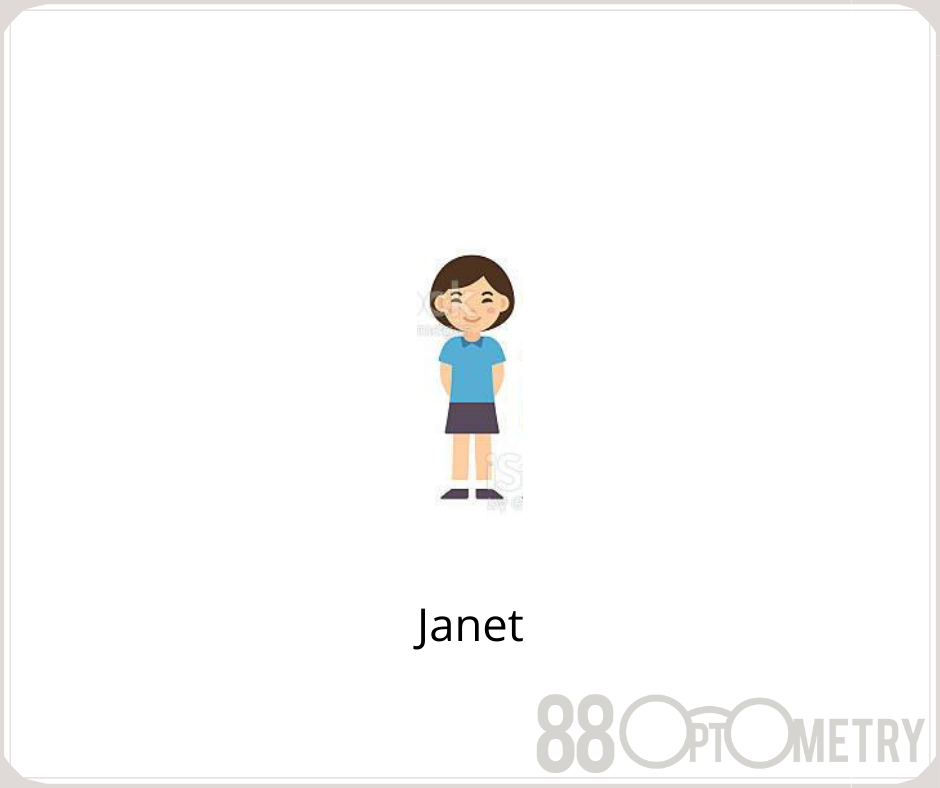Janet (F/26) came for eye examination, vision with existing glasses of 2 years(made with us) is fine seeing far.. and we prescribe a separate pair for computer use due to her esophoric eye posture and she reported feeling better wearing the separate pair when viewing computer. She is also an occasional daily contact lens wearer.
Vision without glasses
R: 6/60-2
L: 6/60-1 (better eye)
Vision with glasses
R: -5.00/-0.75×180 (6/6)
L: -5.00/-0.75×180 (6/9-, 6/7.5-3)
Examination shows:
R: -5.50/-0.50×180 (6/6) (+1.00 blur lens test 6/9) [R: right dominant eye] R>L
L: -5.25/-0.50×180 (6/6) (+1.00 blur lens test 6/12+)
Add: +1.00
Other assessments show:
Examination of Eye Alignment/Vergence (Cover Test)
NMD @Distance
small EP, moderate recovery @Near
(normal value: orthophoria/NMD-No Movement Detected or small XP, fast recovery)
EP = Esophoria is misalignment of the eye, eye is deviated inwards
XP = Exophoria is misalignment of the eye, eye is deviated outwards
Examination of Eye Alignment/Posture (Howell Card) by 6^ Base Down on Right eye
Distance: 0 – 1 EP (yellow part) slightly over 1 EP
Near: 1 – 3 EP (yellow part) stops at 3 EP
+1.00 Near: 0 – 1 XP (yellow part) stops middle of 0-1
+2.00 Near: 0 – 2 XP (blue part)
(normal value: 0-1 EP or 0-3 XP @Distance; and 0-6 XP @Near)
EP = Esophoria is misalignment of the eye, eye is deviated inwards
XP = Exophoria is misalignment of the eye, eye is deviated outwards
Sometimes, when we check monocularly (test 1 eye & cover another eye), you tend to want sharp 6/6 vision with 1 eye, but this sometimes may not be as comfortable for our eyes binocularly/with both eyes. For Janet, it is driving her eyes to be more esophoric. When we reduce shortsightedness/myopia of 025 in both eyes, it relieves the esophoric tense a bit.
Modified power
R: -5.25/-0.50×180
L: -5.00/-0.50×180
Add: +1.00
Eye Alignment/Posture (Howell Card) by 6^ Base Down on Right eye
Distance: 0
Near: 0 – 1 EP (yellow part)
+1.00 Near: 0 – 2 XP (blue part) stops at 2
(normal value: 0-1 EP or 0-3 XP @Distance; and 0-6 XP @Near)
EP = Esophoria is misalignment of the eye, eye is deviated inwards
XP = Exophoria is misalignment of the eye, eye is deviated outwards
Other assessments show:
NRA (Accommodation analysis – ability to relax accommodation) by plus lens
+2.50
(normal value: +1.50 to +2.50)
PRA (Accommodation analysis – ability to stimulate accommodation) by minus lens
-0.25
(normal value: -1.37 to -3.37)
MEM (Accommodation lag – to measure accommodation response seeing near target)
R: +1.25
L: +1.25 (dim reflex)
(normal value: +0.25 to +0.75)
Facility (Accommodation facility – ability to change focus: far to near or near to far) by Flipper +/- 2.00
BE: 13 cycle per minit(cpm), difficult with minus lens (2nd lens)
R: 14 cycle per minit(cpm), difficult with minus lens(2nd lens)
L: 12 cycle per minit(cpm), difficult with minus lens(2nd lens)
(normal value: 1 cycle = 2 words read
Monocular or R/L: 6cpm to 16cpm
Binocular or BE-both eyes: 4cpm to 14cpm)
Fusional Reserves (Convergent/Divergent reserve stamina) by Prism Bar
Near, Base-In/Divergent, NFV: x/18/8
Near, Base-Out/Convergent, PFV: 10/20/18
Distance, Base-In/Divergent, NFV: 4/10/8
Distance, Base-Out/Convergent, PFV: x/8/4
(normal value: Blur/Break/Recovery)
Near, PFV: x/10-28/7-21
Near, NFV: x/7-19/5-15
Distance, PFV: x/4-18/5-9
Distance, NFV: x/4-10/2-6
[Scheiman – Adult Data]
AA (Amplitude Accommodation/Focusing – eye stamina/ability of eye to focus & sustain seeing near clearly) by RAF rule
R: 10 YO, 10 YO, 10 YO (eyes are tensed & head leans backwards when testing gets closer
L: 10 YO, 10 YO, 10 YO (eyes are tensed & head leans backwards when testing gets closer)
(normal value: AA goes according to age; YO=years old)
NPC (Convergence – ability of eye to maintain a single clear near image) by RAF rule
TTN, TTN, TTN, TTN
(normal value: Break/Recovery in less than 10cm or to the nose, TTN)
Interpupillary Distance = 6.5cm
Janet still has some esophoric near posture but it is normalised to 2 exophoria with added plus lens at near. Great! Having slight esophoria, we look at her NFV @near & its recovery is low.. normally, recovery point should be within 4-6^ from the break point.. and her recovery is 8^ from her break point of 18^.. so this takes about 10^.. research stated that this could be a sign of decompensated esophoria… though her NFV @near seems within normal limit.
Besides, other findings suggest suboptimal accommodation.. we know from these findings: 1) high lag MEM, 2) very low PRA & 3) difficulty in minus lenses.. but her AA/eye stamina seems fine.
Given added plus lenses at near, she feels much more comfortable seeing near on top of regulating her eye posture. Depending on her lifestyle, she can continue with a separate computer glasses or she can opt for spectacle lenses with added plus at near so that she does not need to switch glasses between seeing far & near vision. Some contact lenses would be good in supporting her accommodation/focusing too.

